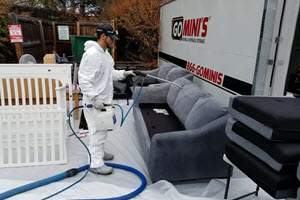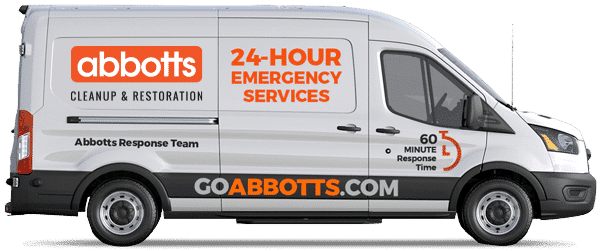What to Do After Your House Floods

Whether your house has flooded as a result of a burst pipe, heavy rains, river overflow, or a home appliance malfunction, time is of the essence when it comes to getting the water out of your home and minimizing the damage. You will need to know what to do if your house floods, including the immediate steps to take and tips on cleaning up after a flood. For some helpful tips on what to do with your flooded possessions please visit our YouTube video.
Safety First
The first step, of course, is ensuring your and your family’s safety. If the house needs to be evacuated, do so, and if only a small area of the home is flooded, take care when interacting with this area. As you know, electricity and water don’t mix. FEMA recommends turning off the power at the main breaker of the fuse box, even if your community has lost power during the flood. Consult with an electrician or other professional for advice on your specific situation when it comes to avoiding electrical dangers.
If the flooding impacted your kitchen or areas of your home where food is stored, get rid of any food that may have been contaminated. If you’re unsure, just go ahead and throw away anything you feel unsure about. It is better safe than sorry. Also, be sure to rewash any dishes before using them if they are located in a flooded area.
Once you begin cleanup, protect yourself from potential contaminants in the water by wearing tall rubber boots and gloves. If the water came from an outside source, or is not clear and clean, you may also want to wear a mask to ensure you’re not inhaling toxins. The same goes for cases in which there may be previous mold growth in the are of your home you’re working in, or more than 24 hours have passed since the flooding, and mold spores may have begun to develop.
A good rule of thumb when it comes to determining whether it is safe for homeowners to handle flood cleanup themselves is that if there is less than an inch of clean water, you may be able to clean and dry everything yourself, but if it is unclean water or more than one inch of water, you should plan to call in some help.
Stop the Flooding
Before cleanup can begin, the flooding needs to stop. Locate the source of flooding, and contact the appropriate professional if you cannot stop it on your own. Of course, if the flooding is coming from outdoors, this may not be an option right away, but do what you can to stop more water from entering your home. You may want to use sandbags or check to see whether your sump pump is functioning properly if you have one installed in your basement.
If the source is a burst pipe or an appliance, handle that situation before moving onto flood cleanup.
Think About Your Insurance

If you are going to working with a flood repair service, you will want to contact them first, as they will likely be able to work with the insurance company on your behalf. That said, it is important to loop insurance in early on, either through them or on your own, if you are going to be doing this all yourself. Insurance companies can be slow to handle claims, so working with a company that will advocate on your behalf and knows pitfalls to avoid can be extremely helpful in maximizing your claim.
Depending on the source of flooding, you may be covered by your homeowners insurance, or you may need flood insurance. Sources of flooding from inside the home, that impact only you, are generally covered by homeowners insurance, while flooding that impacts the surrounding area, such as flooding from heavy rainfall, may only be covered by flood insurance.
From the very beginning, document absolutely everything. Take pictures of the water before flood cleanup begins, and throughout the process. Pictures of damage (as well as video) are extremely helpful, and not having them could cause your insurance provider to pay out less on your claim
Your insurance company will also want you to secure your home if you are unable to stay there during this process. You will need to board up any broken windows, and make sure your home is not going to be further damaged by vandals or weather due to damages exposing the interior of your home.
Now, onto important tips on how to go about cleaning up after a flood.
Remove the Water

Remove wet wall boards and baseboards, being sure to take pictures to document the water level, if visually apparent, before doing so. During this stage, also poke holes in your drywall to allow water that is trapped there to drain. It is easy to forget that the water has spread beyond what the eye can see, and will have soaked through porous surfaces and cracks.
Depending on the level of damage to walls, baseboard, floorboards, and drywall, and what needs to be removed and replaced, you may want to work with a contractor or remediation company to ensure that all of these structures are brought back up to code, and the structural integrity of your home is not compromised.
Once all standing water has been removed, and things are just damp, keep the dehumidifiers running and begin the process of drying things using industrial air movers. Particularly in the case of carpeting, you’re going to need to these to make sure everything gets fully dried out.
Avoid Mold On Surfaces
This is, of course, one of the most common themes when it comes to tips on cleaning up your home after a flood. Mold can be extremely dangerous, and needs to be avoided at all costs.
As you’re cleaning up your home and possessions, clean surfaces with a 1-8 mixture of bleach and water to protect against mold. If water sat for more than 24 hours, chances are, you may have some mold on your hands. If you do suspect mold growth, it is best to bring in a mold remediation company to check things out. They will be able to tell you whether you will need further attention to treat mold growth, and give you an estimate.
A full-service remediation such as Abbotts is equipped to handle both flood and mold remediation, which can be very helpful, so you can get everything assessed and handled by the same team.
Cleaning Up Your Possessions

If the water was not clean water, this presents an additional challenge, as porous items in particular could hold onto dangerous toxins and present health concerns.
You need to decide what items are worth restoring and what items you are willing to part with. Generally speaking, the more porous an item is, the more difficult it will be to dry, and the more likely mold or other toxins will be hanging out deep inside of it. This is particularly true for upholstered furniture.
That said, almost any item can be salvaged by a good remediation company. You will just need to get estimates for the cost of the restoration, and decide whether it is worth it to you. For sentimental items in particular, your insurance is not going to see salvaging these items as worth the cost, so some hard decisions may have to be made.
Another category of items that can be costly to restore are documents and photos. These can often be restored, even when the initially appear to be beyond hope, but you will want to work with a qualified restoration company, such as Abbotts, to estimate costs and determine what makes sense for you. To make this process easier, deal with paper goods early on in your flood cleanup process. Check out this blog post for a detailed guide on how to approach this step.
Cleaning up after a flood is something that needs to be done as quickly, thoroughly, and safely as possible. Your first responsibility is keeping yourself and your family safe, and your second is working with professionals to ensure you get all of the water out and avoid harmful contaminants creating a health danger in the future.
This situation is bound to feel overwhelming, and there is a lot at stake. The faster the water is cleaned up, the less damage you will see. Working with a qualified flood remediation specialist like Abbotts Fire and Flood will allow you to know that you are doing everything you can to minimize damage to your home and belongings, while keeping your home safe from mold and other contaminants.

